13 automated customer service examples to streamline your customer support
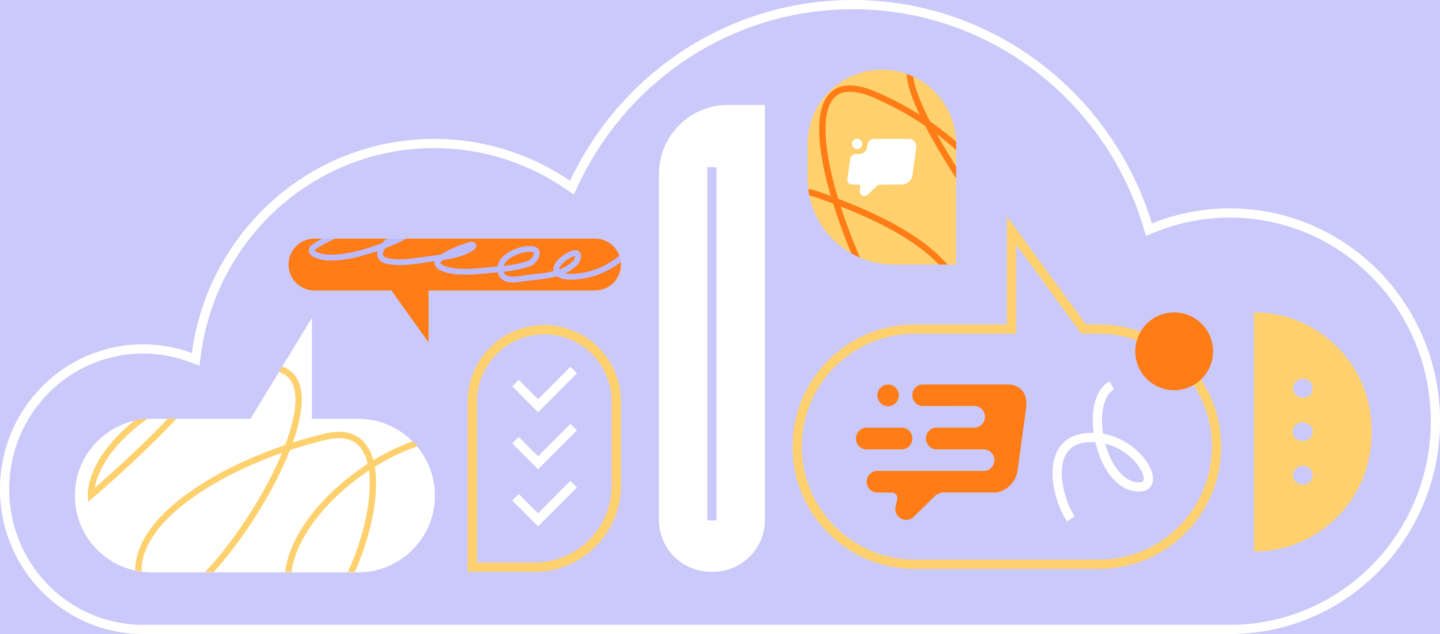
Every customer support team hits a wall.
Your team is swamped with repetitive questions. Response times grow. Agents are overwhelmed. And you’re constantly being asked to do more — with the same number of people.
That’s where automated customer service comes in.
It’s not about replacing your support agents — it’s about freeing them from busywork, so they can focus on complex, meaningful conversations.
And no, you don’t need a massive budget or engineering team to start. Many of these automation solutions are plug-and-play.
In this guide, you’ll find 13 real-world automated customer service examples — from quick fixes like auto-routing to smarter chatbots and survey flows. You’ll see what’s possible, how others are doing it, and where tools like Dashly can help.
What is automated customer service and why it matters for modern customer support
Automated customer service refers to using technology to resolve customer queries without human involvement. This includes chatbots, autoresponders, self-service portals, and workflow automation.
The goal? Fewer repetitive tickets. Shorter response times. And less pressure on your support team.
The rise of automated customer service in modern support teams
With ticket volumes rising and customers expecting instant replies, manual support just can’t keep up.
That’s why more businesses — from SaaS startups to ecommerce brands — are turning to automated customer service for common tasks like:
- Answering FAQs with chatbots
- Auto-routing tickets to the right agent
- Sending order updates without human touch
- Collecting feedback after a conversation
And because modern tools (like Dashly) are easier to deploy than ever, even small teams can start with automation — and scale gradually.
How chatbots deliver fast, automated responses to everyday customer questions
Chatbots are the front line of most automated customer service strategies. They help customers instantly — before a human even sees the ticket.
You can use AI chatbots to:
- Answer common product questions
- Collect key info before a handoff
- Recommend help docs
- Share order status or pricing info
They work across websites, apps, and messengers — and they’re always on.
Real chatbots in action: use cases from SaaS and eLearning
Here’s how smart chatbots solve real customer problems without human effort:
For SaaS teams:
- A user types, “How can I integrate this with Slack?” — the chatbot pulls an integration guide from your knowledge base and shares it in seconds.
- A new trial user asks, “What’s the difference between the Basic and Pro plans?” — the bot answers using your pricing page and offers to book a demo.
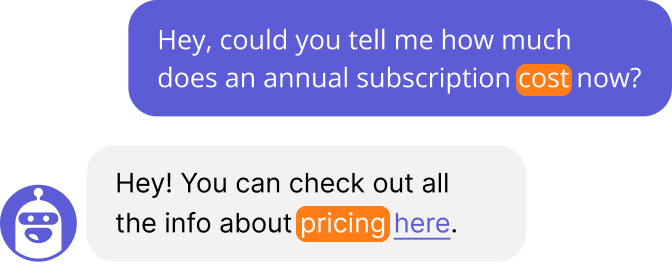
For eLearning platforms:
- A learner asks, “Where can I download my course certificate?” — the bot detects intent, shares a help article, and offers a download link.
- A parent writes, “My child can’t log in to the classroom” — the bot collects the user’s email and device info, triggers a password reset flow, and escalates only if needed.
With Dashly, you can build all of these automated flows without code. That means faster replies, happier customers, and more time for your support team to focus on complex questions.
Using canned message templates to improve speed and consistency in customer service
Canned messages (or saved replies) are one of the easiest automation solutions to implement. They help your support team answer repeat questions in seconds — with consistent tone and content.
They aren’t just time-savers. They also help new customer service agents get up to speed faster and reduce response errors.

How a canned message library speeds up customer replies
A good canned message library includes saved answers for:
- Pricing and billing questions
- Refund policies
- Account access issues
- “Let me check that for you” type replies
- Step-by-step troubleshooting instructions
In Dashly, agents can access these templates directly from the shared inbox. When customers ask a common question, agents can send a perfect reply with two clicks — no need to copy-paste or retype anything.
It’s a small tweak, but over hundreds of conversations? It saves hours every week.
Automated ticket routing: how automation solutions connect the right customer to the right agent
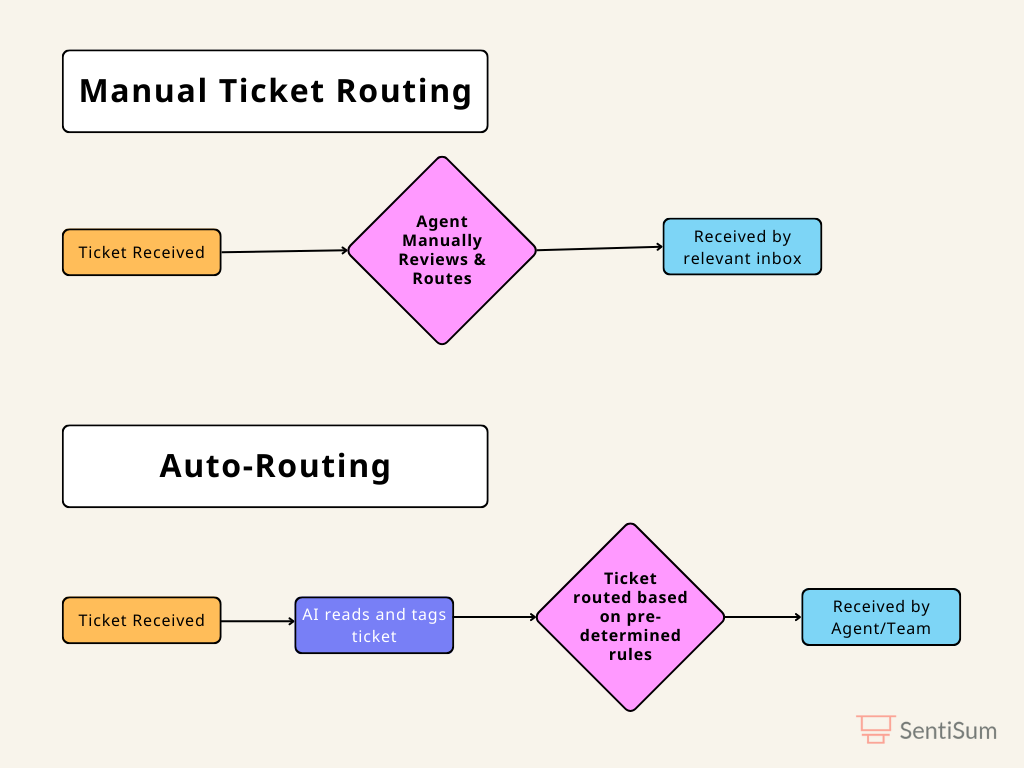
Routing is where many customer service delays start. A customer asks a question. It lands in the wrong inbox. Agents forward it. The clock ticks.
Automated ticket routing solves this. It sends each new question to the right agent, team, or channel — automatically.
Automating customer support routing with rules and AI
Here’s how it works:
- A VIP customer writes in → the ticket goes to your senior support team
- A user selects “billing” in a chat form → it’s routed to your finance specialist
- The message contains the word “cancel” → it goes to a retention-trained agent
Platforms like Intercom or Zendesk let you combine rule-based logic with intent detection to route tickets with precision.
You can use filters such as:
- Message content or keywords
- Customer type, plan, or status
- Source channel (email, chat, socials)
- Language or region
- Business hours or agent availability
The result? Less triaging, more solving. That means a smoother customer support experience and better productivity across your service team.
Creating tickets from forms and live chat: automated customer workflows that save support time
Manually logging chats into tickets? That’s over.
Customer support platforms now generate tickets instantly from automated interactions — whether it’s a form submission, chat widget, or email.
Using automated ticket creation to reduce customer service delays
Here’s a typical scenario:
- A user fills out a “Contact us” form
- Their message is logged instantly as a ticket
- It’s auto-tagged and assigned to the right support team
- A confirmation email is sent automatically
- All details are linked to the customer profile for future reference
With most modern ticketing systems, this entire workflow happens without any manual input. Agents don’t need to copy-paste or check multiple inboxes. Everything is centralized and categorized.
You can also define rules like:
- “Create a ticket if the chat is unresolved after 5 minutes”
- “Auto-prioritize tickets with specific keywords”
- “Assign billing-related forms to the finance queue”
These automated customer flows reduce lag, minimize errors, and help your service team stay focused on resolution — not logistics.
Triggering automated service status updates to keep the customer informed — without lifting a finger
No one likes asking, “Where’s my refund?” or “Has this been solved yet?”
Automated service status updates prevent those questions altogether by proactively keeping the customer in the loop. Whether it’s a shipping delay, a case update, or a feature fix—it should be shared automatically.
Examples of automated service updates in ecommerce and SaaS
Examples of automated updates you can build:
- SaaS: When a user reports a bug, they get a message once it’s marked “fixed”
- EdTech: A student submits an assignment → system notifies them when it’s graded
- Subscription: A customer pauses billing → they receive a confirmation + reactivation timeline
- Support: When a form is submitted, the user gets a ticket number and expected reply window
These types of automated customer notifications reduce anxiety and lower ticket volume. No need for the customer to follow up. No pressure on the agent to send manual updates.
Set it once, and let the system work for you.
Boosting customer service efficiency with in-chat automation from your knowledge base
Let’s be honest: most users don’t go digging through your help docs. But that doesn’t mean you can’t get helpful answers in front of them — right where they ask for it.
That’s where customer service automation meets real-time help.
How to link your customer service content to in-chat experiences
In Dashly, you can create a dedicated knowledge base where users can search for answers using a built-in search bar. It’s especially helpful for handling repeat questions without tying up your support team.
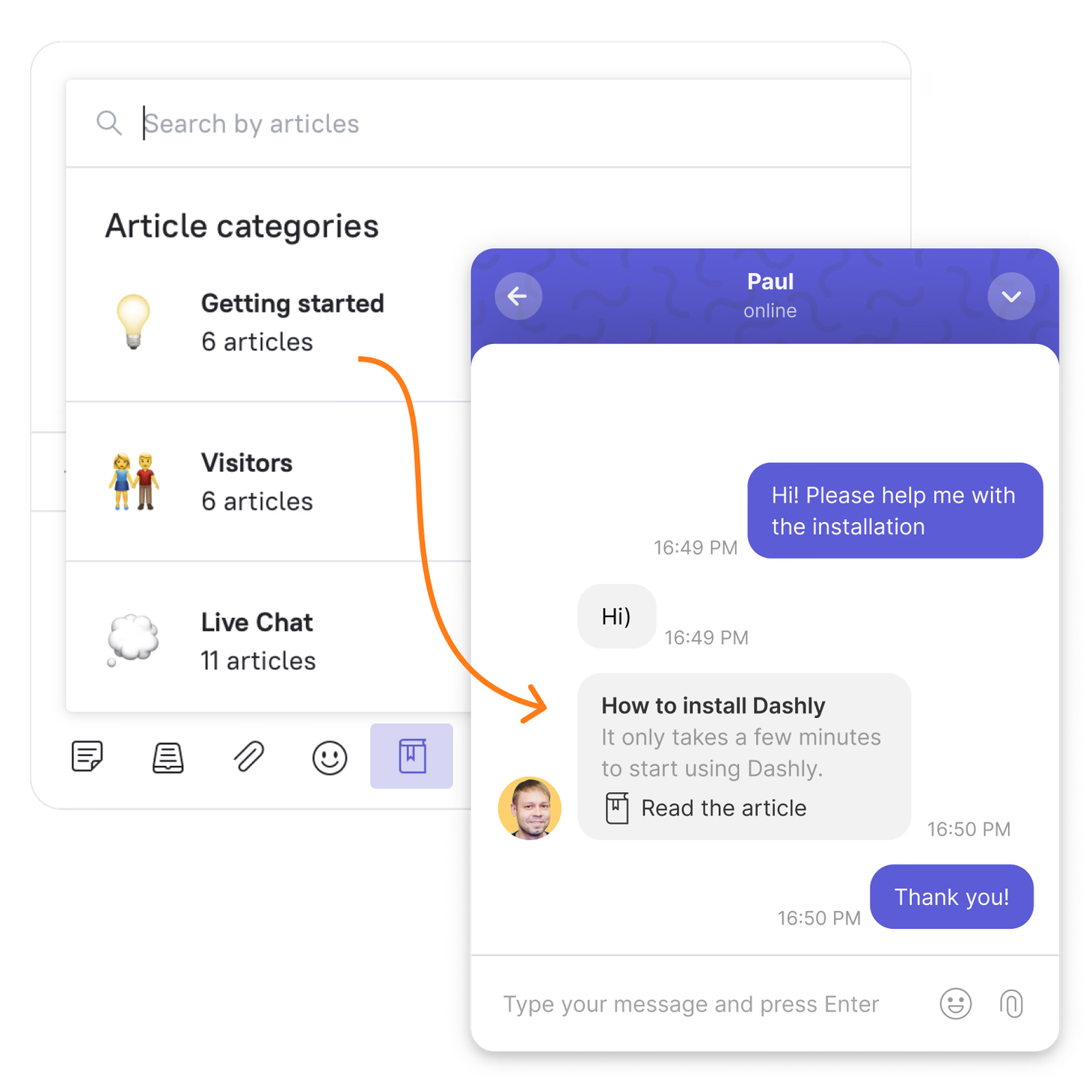
Here’s how it works in practice:
- A customer opens the chat to ask a question
- The agent quickly drops a relevant help article link into the conversation
- The user clicks and views the answer immediately — no need to wait or repeat themselves
- The same article is also available via the knowledge base search bar at any time
This blend of real-time guidance and self-service allows you to:
- Keep your customer service queue lighter
- Help users help themselves
- Maintain consistent answers across the team
It’s a simple but powerful automation tactic that improves efficiency without needing AI or advanced routing systems.
Asking for feedback automatically: automated CSAT flows that improve customer service
Collecting feedback after a support conversation is critical — but asking manually just doesn’t scale.
With automated feedback flows, your customer service platform can trigger surveys at the perfect moment: after a chat ends, a form is submitted, or a ticket is closed.
This gives you consistent data to track quality and spot gaps — without chasing customers.
Setting up automated feedback surveys after every customer interaction
Here’s how an automated customer feedback loop might look:
- A user closes a chat → a CSAT survey pops up in the widget
- A help article is rated → you log the score + optional comments
- A ticket is resolved → they get a follow-up email asking, “How did we do?”
Common rating types include:
- 1–5 stars
- Thumbs up/down
- Emoji scales
- Short-text boxes
Tools like Dashly, Zendesk, and Help Scout let you automate this entire process. You choose the trigger, design the question, and view results in your dashboard.
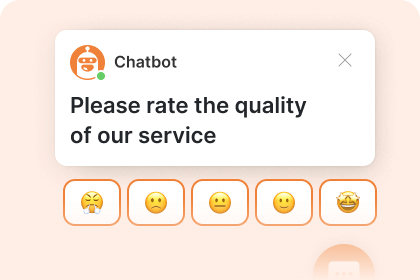
The result: more customer service insight with zero manual effort.
Auto-generating conversation summaries for customer service teams
Customer support doesn’t stop when a chat ends.
For many teams, the real work starts after: reviewing cases, handing off to other departments, and reporting on trends. That’s where automated conversation summaries come in.
Giving support agents context instantly with automated summaries
Instead of reading through entire chat logs, agents (or managers) can view clean, AI-generated summaries that highlight:
- What the customer asked
- What the agent responded
- Whether the issue was resolved
- Any links or actions taken
- Follow-up steps (if any)
These summaries are useful for:
- Onboarding new team members
- Auditing complex cases
- Analyzing support trends
- Preparing escalation notes
Some tools like Klaus or ChatGPT-integrated systems allow you to automate this flow — freeing your service team from writing recaps and digging through logs.
Onboarding customers with automated proactive messages — even while your team sleeps
Onboarding is one of the most high-impact parts of the customer journey — and also one of the most time-consuming for support teams.
That’s why proactive, automated onboarding flows are a must. Instead of waiting for new users to ask questions, you guide them through the next steps automatically
Dashly’s messaging engine for customer onboarding automation
In Dashly, you can build a welcome sequence that blends chat and email automation to onboard new customers without lifting a finger.
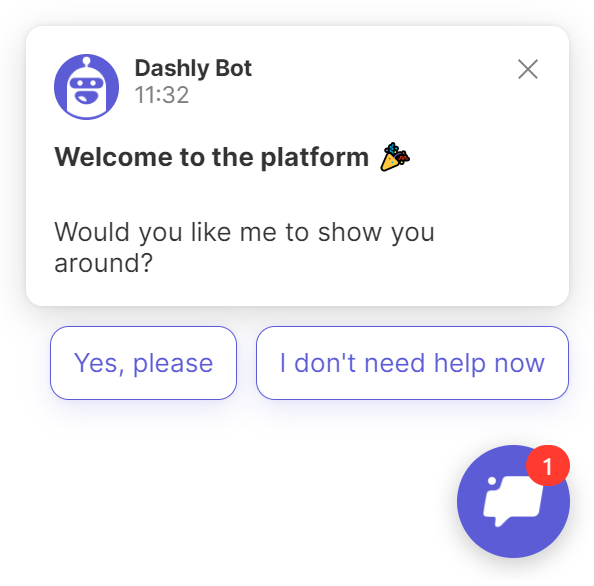
For example:
- A new user signs up → the Dashly chatbot appears with a tour of the dashboard
- They hit a key milestone (like installing a script) → they get a triggered message explaining what’s next
- Haven’t completed onboarding in 3 days? → Dashly sends an email reminder with helpful links
These automated sequences can include:
- Video tutorials
- Feature deep dives
- Setup checklists
- Invitations to talk to a real person
And they don’t just improve retention — they reduce repetitive questions to your customer support team by 20–40%.
6 real automated customer service examples you can implement with Dashly
Dashly’s platform is designed to help support teams stop answering the same questions over and over.
Instead of staffing up, you automate the repeatable—and free your agents for what actually needs a human.
Common automated customer service flows supported by Dashly
Dashly’s AI support bot can handle up to 40% of all user queries without any human involvement.
Here’s how it works:
- It learns from your help docs, website content, and product materials in about 3 minutes.
- When a customer asks a question, the bot instantly responds using this knowledge.
- If it can’t find a confident answer, it routes the chat to a live agent — no frustration, no dead ends.
And that’s just one way Dashly helps you automate support. Other automated customer service flows include:
- User behavior tracking to identify inactive or at-risk users (e.g. missed onboarding steps, feature drop-off) to proactively engage them;
- Chatbots for in-chat feedback collection on your team’s performance;
- Knowledge base articles shared by agents directly in cha;
- Follow-up messages to make sure the issue is resolved or to offer additional help
These flows reduce incoming ticket volume and let your customer support team focus on the cases that need a human touch.
Why Dashly works best for growing customer support teams
Dashly isn’t just a chatbot. It’s a customer service automation platform built for SaaS, EdTech, and service-based businesses that want to:
- Handle high volumes of customer questions with limited resources
- Automate onboarding, support, and follow-up in one place
- Empower agents with saved replies, notes, and multichannel inbox tools
- Get weekly performance insights on what automation is saving you
Why Dashly’s automation stands out for SaaS
- Built for fast-moving, lean support teams;
- AI-driven for efficiency of your team;
- Real-time edits without developer support
- Integrates with your CRM and analytics tools
Getting started with Dashly
Want to automate 40% of your incoming support conversations?
Try Dashly’s AI chatbot and agent tools for free — no credit card needed. Start small, scale smart.
Benefits of customer service automation tools for customer experience and operational costs
Customer service automation isn’t just about saving your support team time — it directly improves your customer experience, too.
Done right, it makes help feel fast, consistent, and always available.
How automation solutions help reduce costs and improve service quality
Here’s what you gain with the right automation tools in place:
- Lower costs per conversation
You don’t need to scale your team linearly with ticket volume. Bots and workflows do the heavy lifting. - Faster resolution times
Instant replies = happier customers. You resolve more without burning out your agents. - 24/7 support coverage
With bots handling FAQs and simple issues, your team doesn’t need to work nights or weekends. - Consistent answers
Say goodbye to off-brand replies or incomplete help. Canned messages and knowledge base links ensure accuracy. - Scalable onboarding and education
Send the right message at the right time, based on user behavior—not guesswork. - Stronger retention rates
Proactive engagement (like checking in with silent or at-risk customers) prevents churn before it starts.
3 signs it’s time to automate your support
- Your agents are handling the same 5 questions every day
- You’re struggling to hit SLA targets with a lean team
- New customers keep dropping off before onboarding is complete
How to start automating customer service without breaking your existing workflows
Getting started with automated customer service doesn’t require a total system overhaul. It’s all about picking the right place to begin — and testing from there.
3 no-risk ways to test automated flows in your customer service process
- Add a few canned messages for your most common replies
- Create a basic feedback survey that sends after chat closes
- Link your help docs to your live chat tool or chatbot
Simple steps, measurable impact.
What to automate first for better customer experience
Start with:
- Repetitive questions
- Slow handoffs between agents or teams
- Missed onboarding follow-ups
- “Where is my…” type queries
- Feedback collection and NPS triggers
Mistakes to avoid when setting up automated customer systems
- Don’t try to automate everything at once
- Avoid generic, robotic bot language—make it sound human
- Don’t leave users stuck in a loop with no agent fallback
- Avoid launching without tracking performance or feedback
8 automation tasks to start with in your support team
- Respond to FAQs via chatbot
- Collect user feedback after a chat
- Send a welcome message after signup
- Remind inactive users to finish onboarding
- Route questions by topic or urgency
- Share knowledge base articles in-chat
- Follow up on unresolved issues
- Notify users when tickets are resolved
Conclusion: Start small, scale smart
Customer service automation isn’t an “all or nothing” strategy. It’s about finding the repeatable, time-draining parts of your process — and giving them to systems that don’t sleep, get tired, or forget.
Whether you’re supporting 500 users or 50,000, tools like chatbots, feedback flows, and onboarding messages can help you scale customer support without scaling your team.
And when you’re ready to launch your first automated flows, Dashly makes it easy to test, iterate, and measure results — without code.
Ready to reduce support load and speed up help?
FAQ
Automated customer service uses technology — like chatbots, auto-replies, or workflows — to resolve customer questions without a human agent. It reduces workload, speeds up response times, and provides consistent support 24/7.
Examples include helping with account access, providing product setup guidance, answering billing questions, sharing shipping updates, and resolving complaints over chat or email.
Support automation includes using chatbots for FAQs, triggering CSAT surveys, routing tickets by topic, sending onboarding emails, and updating users when tickets are resolved.
A typical automated call center uses voice menus (IVR), AI-powered bots, and call routing to answer common inquiries — like checking order status or resetting passwords — before escalating to a live agent.
Intelligent routing analyzes data like keywords, user history, or contact reason to automatically send each inquiry to the best-suited agent or department — saving time for both the customer and your team.
Start by identifying repeat tickets, like billing or login issues. Set up canned replies, connect your knowledge base to chat, or try a simple chatbot flow for FAQs to see instant impact.




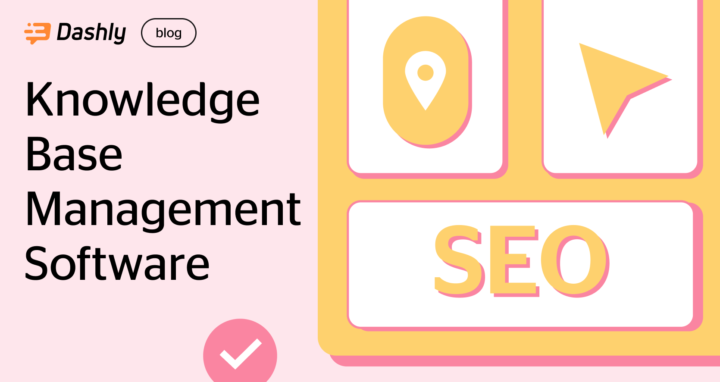
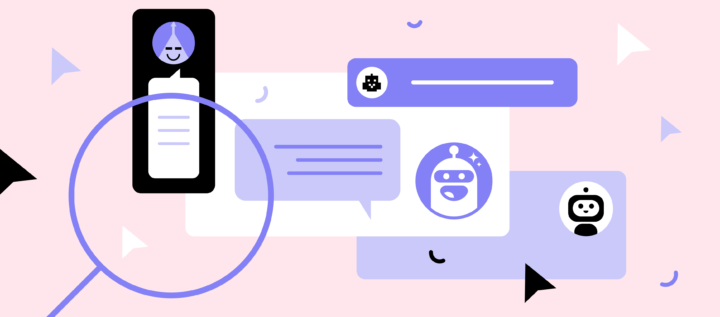

![Create a student journey mapping for online school [4 map templates]](https://www.dashly.io/blog/wp-content/uploads/2023/04/image-3-720x317.jpg)

